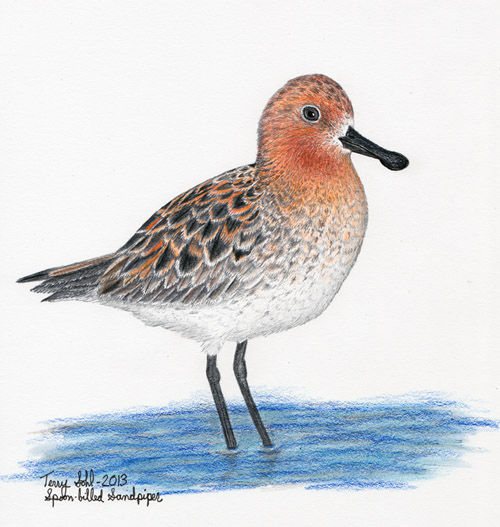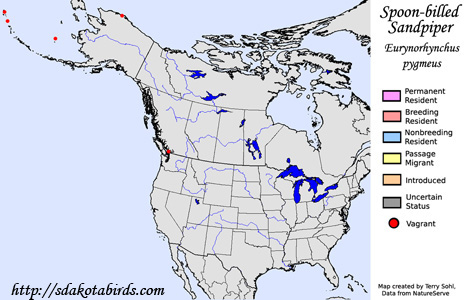| Length: 8.5 inches | Wingspan: 18 inches | Seasonality: Non-resident in South Dakota |
| ID Keys: Distinctive spatulate bill. Breeding plumage - Rich rufous-brown head, neck and upper breast, white underparts, black legs. Non-breeding birds lack rich rufous tones. | ||
 The
Spoon-billed Sandpiper is a unique small sandpiper that breeds in Siberia,
and winters in Southeast Asia. In North America, they are but very rare
vagrants, with a handful of sightings in Alaska and elsewhere in western
North America. Numbers of Spoon-billed Sandpipers have never been very
high, as they breed in a relatively small geographic area with very specific
habitat requirements. However, in the last few decades, populations
have drastically declined, and the Spoon-billed Sandpiper is now one of the
most endangered birds on the planet. As of 2012, perhaps only 100
breeding pairs remain. Threats to the species are many, and include
loss of crucial estuary and mudflat habitat on their migration route from
eastern Russia to southeastern Asia. One factor that has undoubtedly
taken a heavy toll though is subsistence hunting of shorebirds by
impoverished locals in Myanmar, one of the areas Spoon-billed Sandpipers use
as wintering grounds. Locals in Myanmar use fine netting on mudflats
to capture shorebirds for sustenance. Given the very small population
of Spoon-billed Sandpipers, it's very possible for a single net setup to
capture a substantial portion of the remaining population. Conservation
efforts are underway to try to save the Spoon-billed Sandpiper, but many
believe the species could be extinct in as little as 5 years.
The
Spoon-billed Sandpiper is a unique small sandpiper that breeds in Siberia,
and winters in Southeast Asia. In North America, they are but very rare
vagrants, with a handful of sightings in Alaska and elsewhere in western
North America. Numbers of Spoon-billed Sandpipers have never been very
high, as they breed in a relatively small geographic area with very specific
habitat requirements. However, in the last few decades, populations
have drastically declined, and the Spoon-billed Sandpiper is now one of the
most endangered birds on the planet. As of 2012, perhaps only 100
breeding pairs remain. Threats to the species are many, and include
loss of crucial estuary and mudflat habitat on their migration route from
eastern Russia to southeastern Asia. One factor that has undoubtedly
taken a heavy toll though is subsistence hunting of shorebirds by
impoverished locals in Myanmar, one of the areas Spoon-billed Sandpipers use
as wintering grounds. Locals in Myanmar use fine netting on mudflats
to capture shorebirds for sustenance. Given the very small population
of Spoon-billed Sandpipers, it's very possible for a single net setup to
capture a substantial portion of the remaining population. Conservation
efforts are underway to try to save the Spoon-billed Sandpiper, but many
believe the species could be extinct in as little as 5 years.
Habitat: One reason for the small population is the very specific habitat requirements for breeding. They only breed in lagoon areas along the coast with vegetation consisting of stunted birch and willow, or crowberry and lichen. They also require mudflats or shallow-water estuaries near their breeding locations, to provide foraging opportunities. During migration and in winter, they prefer sandy mudflats with extensive areas of shallow water.
Diet: Feeds a variety of small invertebrates such as small crustaceans, mollusks, marine worms, and insects. The nest is a depression in the ground, lined with moss and leaves. The female lays 3 or 4 eggs, and both parents help to incubate them. When the eggs hatch, the young soon leave the nest and obtain their own food. The female typically leaves soon after the eggs hatch, leaving the male to tend to the young and protect them until they fledge.
Behavior: Forages by walking in shallow water, putting its head down and sweeping its bill from side-to-side, searching for small invertebrates. They will also sometimes use their bill to prove in a soft muddy or sandy bottom.
Nesting: The Spoon-billed Sandpiper has a very strong nest-site fidelity, returning to the same nesting location year after year.
Song: The song of a Spoon-billed Sandpiper is a buzzy, descending trill, given by the male while performing flight displays.
Interactive eBird map: Click here to access an interactive eBird map of Spoon-billed Sandpiper sightings
Migration: Strongly migratory, breeding in the far eastern Russia along the coast, and wintering in southeast Asia.
Similar Species: Could be confused with Red-necked Stint or Little Stint.
Conservation Status: Populations have plummeted, and very few birds remain. The IUCN lists the Spoon-billed Sandpiper as "Critically Endangered".
Further Information: 1) BirdLife International - Spoon-billed Sandpiper
2) ARKIVE - Spoon-billed Sandpiper
3) Audubon Magazine - Fighting to save the Spoon-billed Sandpiper from Extinction in Five Years
Image Information: Colored pencil drawing, by Terry Sohl (2013)
| Click below for a higher-resolution map |
 |
| South Dakota Status: Non-resident in South Dakota |
Additional Spoon-billed Sandpiper Images
Click for a higher-resolution version of these photos

